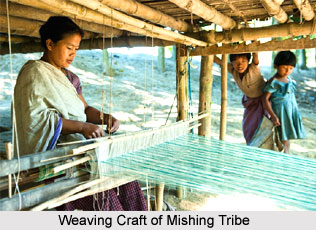 The Mishing tribes also known as Miri by the local people, have mainly settled along the south western belt bordering Assam. They are a part of Mongoloid group of people and consist of several loosely knitted groups. The main source of income of the Mishings is agriculture. They also practise shifting cultivation. The weaving industry represents the traditional legacy of the Mishings. The array of items woven depicts the artistic mastery of the craftsmen.
The Mishing tribes also known as Miri by the local people, have mainly settled along the south western belt bordering Assam. They are a part of Mongoloid group of people and consist of several loosely knitted groups. The main source of income of the Mishings is agriculture. They also practise shifting cultivation. The weaving industry represents the traditional legacy of the Mishings. The array of items woven depicts the artistic mastery of the craftsmen.
Designs of Weaving Crafts of Mishing Tribe
The Mishings are engaged in nurturing the weaving craft since time immemorial. The typical usage of designs, unique colour combinations and selection of motif prominently characterize the Mishing clothes. Among the Mishings it is compulsory to dress in self woven clothes during the weddings. Priority is mostly given to bright vivid colours and the clothes are exclusively designed using different colour threads like orange, yellow, green, black and red. The dress materials consist of specific designs of nature, trees, sceneries, group of flying birds, sprays of towers, various geometrical patterns, stars and others. These people have also preserved their rich traditional textile motifs. Special designs and motifs have also been borrowed from the neighbouring communities and well implemented. The local craftsmen usually design the traditional clothes using floral patterns, images of animals like elephants inter-spread with lions, deer, horses, leaves, birds and spring. Traditional motifs like fish, cons and crossed swords, etc. are also employed. The Mishing textiles also use motifs on white, black or other background colours thus, providing them with an exotic look and style. The bird motifs are usually kept in red and white colour. They are mostly triangular in shapes and rhythmically follow a triangular pattern. In comparison to the men`s garments the style, colour combination and design of women`s garments are more intense and brighter. The Mishings have their own traditional techniques of colouring the designing threads. The womenfolk are proficient in the use of simple handlooms for weaving their clothes.
Mirizim is one of the most striking and exotic kind of shawl or blanket of the Mishing community. It is regarded as impressive and precious wedding gift for the newly wed. The mother usually presents a self-woven blanket to the new bride. The womenfolk mostly practise the household tradition of weaving of mirizim that requires a lot of effort and labour. Raw cotton fabrics are used for weaving it. At the first stage the cottonseeds are extracted from cotton and then it is dried. Following this fine threads are spun out in the form of thin cord. These fine threads are then spun with hand spindles and no spinning wheel is used in the entire process. The weaving is done on the simple local loom. Finally it is made into a long lasting blanket that serves as a warm cover during the winter months.
















